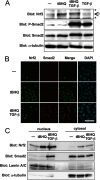Transforming growth factor-β induces transcription factors MafK and Bach1 to suppress expression of the heme oxygenase-1 gene
- PMID: 23737527
- PMCID: PMC3711329
- DOI: 10.1074/jbc.M113.450478
Transforming growth factor-β induces transcription factors MafK and Bach1 to suppress expression of the heme oxygenase-1 gene
Abstract
Transforming growth factor-β (TGF-β) has multiple functions in embryogenesis, adult homeostasis, tissue repair, and development of cancer. Here, we report that TGF-β suppresses the transcriptional activation of the heme oxygenase-1 (HO-1) gene, which is implicated in protection against oxidative injury and lung carcinogenesis. HO-1 is a target of the oxidative stress-responsive transcription factor Nrf2. TGF-β did not affect the stabilization or nuclear accumulation of Nrf2 after stimulation with electrophiles. Instead, TGF-β induced expression of transcription factors MafK and Bach1. Enhanced expression of either MafK or Bach1 was enough to suppress the electrophile-inducible expression of HO-1 even in the presence of accumulated Nrf2 in the nucleus. Knockdown of MafK and Bach1 by siRNA abolished TGF-β-dependent suppression of HO-1. Furthermore, chromatin immunoprecipitation assays revealed that Nrf2 substitutes for Bach1 at the antioxidant response elements (E1 and E2), which are responsible for the induction of HO-1 in response to oxidative stress. On the other hand, pretreatment with TGF-β suppressed binding of Nrf2 to both E1 and E2 but marginally increased the binding of MafK to E2 together with Smads. As TGF-β is activated after tissue injury and in the process of cancer development, these findings suggest a novel mechanism by which damaged tissue becomes vulnerable to oxidative stress and xenobiotics.
Keywords: Cancer; Cancer Prevention; Heme Oxygenase; Nrf2; Oxidative Stress; Transcriptional Regulation; Transforming Growth Factor β (TGFβ).
Figures







Similar articles
-
Gold nanoparticles induce heme oxygenase-1 expression through Nrf2 activation and Bach1 export in human vascular endothelial cells.Int J Nanomedicine. 2015 Sep 21;10:5925-39. doi: 10.2147/IJN.S88514. eCollection 2015. Int J Nanomedicine. 2015. PMID: 26445536 Free PMC article.
-
Antioxidant-induced phosphorylation of tyrosine 486 leads to rapid nuclear export of Bach1 that allows Nrf2 to bind to the antioxidant response element and activate defensive gene expression.J Biol Chem. 2010 Jan 1;285(1):153-62. doi: 10.1074/jbc.M109.040022. Epub 2009 Nov 6. J Biol Chem. 2010. PMID: 19897490 Free PMC article.
-
Characterization of docosahexaenoic acid (DHA)-induced heme oxygenase-1 (HO-1) expression in human cancer cells: the importance of enhanced BTB and CNC homology 1 (Bach1) degradation.J Nutr Biochem. 2014 May;25(5):515-25. doi: 10.1016/j.jnutbio.2013.12.011. Epub 2014 Feb 4. J Nutr Biochem. 2014. PMID: 24613086 Free PMC article.
-
Silencing Bach1 alters aging-related changes in the expression of Nrf2-regulated genes in primary human bronchial epithelial cells.Arch Biochem Biophys. 2019 Sep 15;672:108074. doi: 10.1016/j.abb.2019.108074. Epub 2019 Aug 15. Arch Biochem Biophys. 2019. PMID: 31422075 Review.
-
BACH1, the master regulator gene: A novel candidate target for cancer therapy.Gene. 2016 Aug 15;588(1):30-7. doi: 10.1016/j.gene.2016.04.040. Epub 2016 Apr 22. Gene. 2016. PMID: 27108804 Review.
Cited by
-
High Fractional Occupancy of a Tandem Maf Recognition Element and Its Role in Long-Range β-Globin Gene Regulation.Mol Cell Biol. 2015 Oct 26;36(2):238-50. doi: 10.1128/MCB.00723-15. Print 2016 Jan 15. Mol Cell Biol. 2015. PMID: 26503787 Free PMC article.
-
RNA-binding motif protein 47 inhibits Nrf2 activity to suppress tumor growth in lung adenocarcinoma.Oncogene. 2016 Sep 22;35(38):5000-9. doi: 10.1038/onc.2016.35. Epub 2016 Feb 29. Oncogene. 2016. PMID: 26923328 Free PMC article.
-
Bach1 deficiency reduces severity of osteoarthritis through upregulation of heme oxygenase-1.Arthritis Res Ther. 2015 Oct 13;17:285. doi: 10.1186/s13075-015-0792-1. Arthritis Res Ther. 2015. PMID: 26458773 Free PMC article.
-
Nrf2 protects stellate cells from Smad-dependent cell activation.PLoS One. 2018 Jul 20;13(7):e0201044. doi: 10.1371/journal.pone.0201044. eCollection 2018. PLoS One. 2018. PMID: 30028880 Free PMC article.
-
Crosstalk of protein kinase C ε with Smad2/3 promotes tumor cell proliferation in prostate cancer cells by enhancing aerobic glycolysis.Cell Mol Life Sci. 2018 Dec;75(24):4583-4598. doi: 10.1007/s00018-018-2914-9. Epub 2018 Sep 12. Cell Mol Life Sci. 2018. PMID: 30209539 Free PMC article.
References
-
- Derynck R., Miyazono K. (eds) (2008) The TGF-β Family, Cold Spring Harbor Laboratory Press, Cold Spring Harbor, NY
-
- Massagué J., Seoane J., Wotton D. (2005) Smad transcription factors. Genes Dev. 19, 2783–2810 - PubMed
-
- Siegel P. M., Massagué J. (2003) Cytostatic and apoptotic actions of TGF-β in homeostasis and cancer. Nat. Rev. Cancer 3, 807–821 - PubMed
-
- Akhurst R. J., Derynck R. (2001) TGF-β signaling in cancer—a double-edged sword. Trends Cell Biol. 11, S44–S51 - PubMed
Publication types
MeSH terms
Substances
LinkOut - more resources
Full Text Sources
Other Literature Sources
Research Materials
Miscellaneous

